Mobility in Malta
The first student/teacher mobiliy of the project took place in Malta from the 26th of February 2019 until the 1st of March 2019.
|
|
Our partners from Malta hosted the mobility with great enthusiasm.
Preparations:
The decoration of the premises of San Miguel Resource Centre contributed to create a welcoming atmosphere for the participants. Preparations for the Erasmus week started weeks beforehand. Each classroom was decorated thematically to display the cultures and traditions of the four countries in the project as follows:
class1 – Malta, class 2 - Romania, class 3 - Poland, classes 4 and 6 – Cyprus.
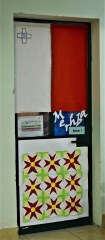 |
 |
 |
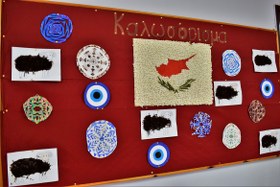 |
 |
The main hall was also decorated to make the Centre more attractive for the occasion. This included the banner with the chosen logo of the Project and various display boards to complement the classrooms’ setting.
Prior to the mobility week, the classes carried out activities about the traditions and the culture of each respective country; namely art and craft sessions as well as cookery sessions of traditional foods.
Lunches and Coffee breaks at the Centre:
The participants were provided with buffet lunches and coffee break snacks at the Centre on Monday and Thursday. Traditional Maltese desserts were prepared by the classes during cookery sessions. These included the traditional “Prinjolata” (a sweet made during the Carnival period), qagħaq ta’ l-għasel (honey rings), mqaret (fig pastries), kwaresimal (a sweet for Lent) and Pudina tal-ħobz (the exceptional Maltese bread pudding).
Snacks that were enjoyed by the participants were pastizzi, bigilla (a dip made from dried broad beans), ġbejniet (cheeselets), Maltese sausage and ħobz biz-zejt (Maltese bread with tomato paste, olive oil, tuna and herbs).
The mobility week programme:
The participants from Cyprus, Poland and Romania arrived in Malta on the 25th of February. The Head of School Ms M. Gatt, together with some students and members of staff welcomed the three contingents at Luqa International Airport.
• Tuesday 26th February (day 1):
The participants from the three countries arrived at San Miguel Resource Centre and they were welcomed by the Head of School Ms Marica Gatt and the Assistant Head Ms. Sandra Cassar. They toured the Centre and were greeted by the classrooms’ staff and students. After a coffee break, all present gathered in the hall and the programme opened with an introduction by the Head of School and the singing of the Erasmus song which was played harmoniously on the saxophone by one of the teachers at San Miguel.
Teaching Techniques
The programme for Tuesday was dedicated to two teaching techniques as follows:
(i) Interactive storytelling:
The first session on the programme consisted of interactive storytelling by another teacher at San Miguel. The story called “Twinkle, Twinkle on Erasmus!” meticulously was prepared by the staff of class 3.
Year 1 students of St Clare College Pembroke Primary School were also present for the storytelling session. These students showed interest and enjoyment throughout the whole session by participating fully and actively.
The lesson plan for the interactive story “Twinkle, Twinkle on Erasmus!” is attached as Appendix B1 of this report.
 |
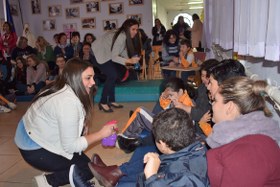 |
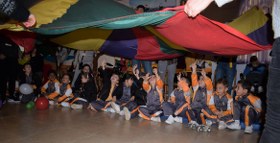 |
|
(II) T- Shirt Printing Activity:
After lunch at the Centre the student participants actively took part in a T Shirt printing activity where they learnt how to create a print on their own T Shirts which were supplied by San Miguel Resource Centre. The prints displayed icons of Maltese culture and history such as the Maltese Cross, the Neolithic Temples and the endemic national flower “Widnet il-Baħar”. The students brought out their creativity by using the cardboard blocks that had been designed in the classrooms during art sessions, to print beautiful unique T –Shirts with acrylic paint.
 |
In the evening the participants of the four countries met for a dinner of delicious, traditional Maltese food at Ta’ Marija Restaurant in Mosta. The evening ended with music and dancing.
• Wednesday 27th February (day 2):
On the second day of the Mobility in Malta the participants were accompanied by San Miguel staff on an outing to Rabat and Mdina to visit the Catacombs of St Paul, the National Museum of Natural History and the Domus Romana. These visits were organised courtesy of Heritage Malta.
St Paul’s Catacombs are a typical complex of interconnected, underground Roman cemeteries that were in use up to the 4th century AD. They are located in the outskirts of the old capital Mdina. The Catacombs represent the earliest and largest evidence of Christianity in Malta.
The National Museum of Natural History in Mdina is situated in the 18th century Vilhena Palace. The display areas in the museum cover various topics such as Maltese Geology and Palaeontology, exotic mammals, marine fauna, shells, insects and birds and other topics like human evolution.
The Domus Romana (Roman House) in Rabat is a ruined Roman era house built in the 1st century BC as an aristocratic town house (domus) within the Roman city of Melite (today Mdina). In the 11th century a Muslim cemetery was established on the remains of the house. The house was discovered in 1881, and archaeological excavations revealed several well-preserved mosaics statues and other artefacts, as well as tombstones and other remains from the cemetery.
The Participants enjoyed lunch at the Peristyle Restaurant in Rabat. In the evening they were joined by their friends in Malta for a dinner in the traditional fishing village of Marsaxlokk in the renowned fish restaurant “La Carrubia”.
Thursday 28th February (day 3):
Thursday morning’s fashion show of traditional clothes was the highlight of the Malta Mobility. Each country’s representatives paraded in attires from various eras. During the parades the students also presented traditional dancing steps.
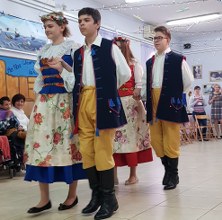 |
 |
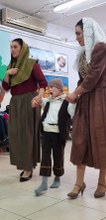 |
 |
After lunch at the Centre the participants attended an interesting Medieval Sword enactment display and they could also learn some sword skills. Afterwards they were also given the opportunity to be guided to put them in practice.
The evening dinner was held at “Crave” Restaurant at the magnificent Valletta Waterfront.
Friday 1st March (day 4):
The last day of the Mobility in Malta was spent at the picturesque Birgu Waterfront which is situated within the so called Three Cities in the Grand Harbour, opposite Valletta.
The participants visited The Inquisitor’s Palace, Fort Saint Angelo and the Maritime Museum in Vittoriosa, courtesy of Heritage Malta. The Inquisitor’s Palace is one of the few surviving Inquisitor’s palaces in the world and the only one accessible to the public. It is an architectural gem, representative of the chequered history and European heritage of the Maltese islands. Fort Saint Angelo was originally built in the medieval period as a castle. It was rebuilt by the Order of the Knights of Saint John as a bastioned fort between the 1530s and the 1560s. It is best known for its role as the Order’s Headquarters during the Great Siege of Malta in 1565.
The Maritime Museum is housed within the Old Naval Bakery. It illustrates the global nature of seafaring and its impact on the Maltese society. The museum houses numerous artefacts highlighting different epochs of Malta’s history that is inadvertently tied to the sea.
The participants ended their visit with lunch at one of the restaurants on the sea front.






